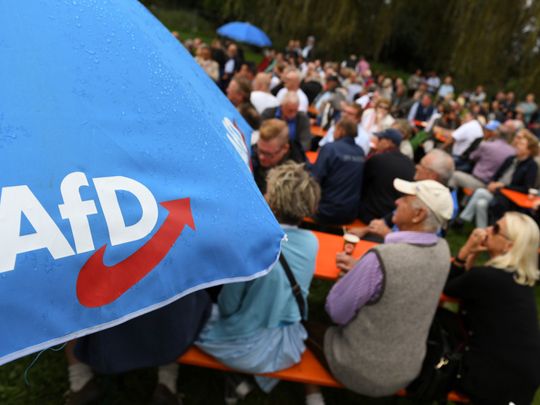
There is a big blue elephant in the room in Germany that’s growing in size by the month. So far, even after last week’s regional elections in the eastern portion of that nation, mainstream political parties are shutting out Alternative for Germany (AfD) when it comes to forming coalitions.
But for how much longer?
The radical far right neo-Nazi party is strongly anti-European Union, Islamophobic and, since it was founded six years ago, is now the third-largest in Germany’s Bundestag — the lower house in the federal parliament with 92 of the 709 seats there. Now, following elections in Saxony and Brandenburg last week, it finished second in both states that were part of the former East Germany and can no longer be considered be a fringe element.
Sadly, AfD and its toxic message of populism and anti-immigrant rhetoric, is now prime time — all the more disappointing given that the Second World War began eight decades ago this week, a conflict that was fuelled by the hatred, racism and fascism now being propagated by these modern-day neo-Nazis.
In Saxony, AfD almost tripled its polling on the previous state ballot, gaining 27.5 per cent of votes and 38 of the 118 seats in the state parliament in Dresden. What’s more, the Christian Democratic Union (CDU) — the party of Angela Merkel — finished just 4.6 per cent ahead of AfD, saw its seats in the Dresden parliament fall from 59 to 45, and will now have to seek a coalition deal with parties on the left or the Greens to continue to govern.
Too toxic to embrace
Over the state border in Brandenburg — an area that surrounds the city of Berlin — AfD doubled its support to 23.5 per cent, taking 23 of the 88 seats, and ending up with just two seats less than the ruling Social Democratic Party (SPD). If there’s any consolation there, it’s that the left vote in Brandenburg did also increase, being splintered among several parties. For the CDU, however, it was a bad day, finishing up with six fewer seats and just 17 per cent support.
Naturally, AfD leaders are over the moon with their showing, saying that theirs is now a true ‘Volkspartei’ — a term for a national party in Germany that had only previously applied to the CDU and the SPD. The German political commentariat is reluctant to accept that just yet. While AfD may be the largest opposition party in the Bundestag given that the CDU and SPD are in coalition, and in national opinion polls it hovers at the 15 per cent level.
Since Sunday’s elections, both the CDU and SPD have ruled out working with AfD in coalition arrangements in either state. It’s simply too toxic a brand to embrace. But for how long can the mainstream parties continue to avoid it given its obvious growing support? And how long too before it does indeed grow to the point where it can power in another state parliament?
That German political commentariat is pointing to Sunday’s results as being a bit of an aberration, arguing that both states have less of a tie to the German federal system, being newcomers since the unification of the country, are more willing to change votes, and the AfD had a message that resonated with protest voters. They also say that no one single issue dominated the campaigns and that only a third of AfD voters cited the influx of refugees as their reason for support in exit polls.
Second-class status
What is interesting though is that 30 years after the fall of the Berlin Wall — the longest lasting legacy of the 1939-1945 conflict and the subsequent Cold War — 66 per cent of Saxony voters and 59 per cent of those in Brandenburg said they believe those now living in the former East Germany are being treated as second-class citizens. When it came to supporters for the AfD, that feeling of second-class status was expressed by almost 80 per cent.
Add in the more than one million refugees who have settled in Germany over the past four years as a result of conflict and violence in Syria and across the Middle East, the manner in which German authorities have welcomed and offered support, and that feeling of second-class citizenry is reinforced, analysts say.
The AfD also benefits in eastern German states by never having been in power — it has no record in government to defend and can standby its untested election promises — and it becomes a perfect vehicle for protest voters.
There are also other elements at play that German political scientists say magnifies support levels for AfD. Since June, the SPD has been without a national leader — a clear voice to unify the party and engage with voters. Andrea Nahles resigned in early June following the party’s dismal showing in the European Parliament elections and it is being led by a trio of interim leaders — hardly an effective way to get a message out or to campaign.
The CDU, too, is undergoing a prolonged renewal, with Merkel set to retire in 2021 and Annagret Kramp-Karrenbauer, a staunchly conservative successor due to succeed her then.
Until then, the AfD seem certain to continue its meteoric rise on the far right.








